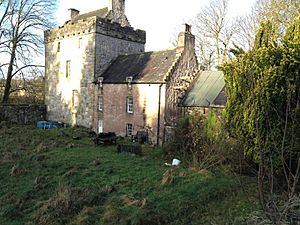Castle Cary Castle facts for kids
Castle Cary Castle is an old tower house from the 1400s. It's about 6 miles (10 km) from Falkirk in Scotland. This castle is also close to where a big Roman fort once stood, part of the famous Antonine Wall. Today, it's a private home.
Contents
A Look Back in Time
The first mention of Castlecary might be from 1304. King Edward I of England sent a message about bringing soldiers to 'Chastel Kary'. Some old Latin writings also talk about a "great Fort and great building called Castle Kæney" near the Antonine Wall.
The tower, which is about 40 feet (12 meters) tall, was probably finished by 1480. Henry Livingstone is thought to have built it. Mary, Queen of Scots is said to have visited the castle. She reportedly planted a yew tree there with her friend, Mary Livingston.
For a long time, the castle belonged to the Livingstone family. Then, it was taken over by the Baillies. In 1730, the castle went to Thomas Dunbar when he married Bethia Baillie.
The castle was burned by a group of Jacobites during the 1715 rebellion. But it was later fixed up. Now, it's a private house and not open to the public.
An old historian named Alexander Baillie was likely born here. His sister, Lizzie, famously ran away from the castle with her lover, Donald Graham. She supposedly jumped from a window into his traditional Scottish plaid! The castle later became the property of the Marquess of Zetland.
What Does the Castle Look Like?
The castle started as a rectangular tower with a smaller wing, making an L-shape. It was built in the late 1400s. Some of the stones used to build it came from the nearby Roman fort of the Antonine Wall. An old historian named Hugo B. Millar, who lived there, said he found many such stones in the castle walls and garden.
The first wing was destroyed. Later, in the 1600s, a new wing was added to the east side of the tower. This part was built in 1679. It had two floors and an attic, plus a spiral staircase.
Both the main tower and the new part have slanted roofs with steps at the top, called crow-stepped gables. The original tower has a fixed-up wall at the top with openings, called a crenellated parapet. There's also a part that sticks out on the north wall, which might have been a toilet (called a Garderobe) or a defensive feature.
A spiral staircase goes from the north entrance up to the top wall. From there, you can enter the attic. On the ground floor, there's a cellar with a rounded ceiling. You can still see parts of 18th-century wall paintings in the main hall. An iron gate, part of the castle's original defenses, is also kept inside.
Underneath the 17th-century wing, there was a wide ditch, about 7.5 meters (25 feet) across. This ditch was filled in when the new wing was built. It might have been there since the castle was first built around 1485.
Castle in Art
In Paintings
A painting of Castlecary Castle by George Gibson is shown at Callendar House in Falkirk.
The Song of Lizzie Baillie
There's a story that Lizzie Baillie of Castlecary jumped out of a third-story window to run away with her boyfriend, Donald Graham. Lizzie's father, who was a well-known historian, really didn't like Donald. There are a few versions of a song about this story. One version, written by Rev. Hugh Baird, says the story is sometimes mixed up with another person named Mary of Castlecary. Baird's whole book is about Castlecary.


